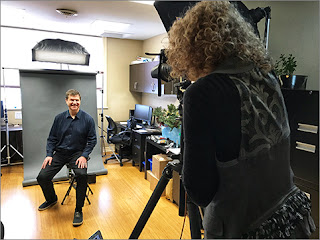 |
| Fantasy In the Forest, July 2018 South Frontenac |
Twenty-four years ago, long before I met them, sculptor Jamie Brick and his wife Annette of South Frontenac, Ontario launched an art show called Fantasy in the Forest. Every summer around the third weekend in July they and an eclectic and ever-expanding group of artists transform a pretty forest glade into a magical kingdom. Thanks to Meghan Balogh and the Kingston Whig Standard I am spared the necessity of describing it further as she has done so very well in her article. In fact, to give credit where it's due, she captured the subject matter in my photo above in her own image and identifies and credits them appropriately. So please do read her article to get the full story!
 | ||
| Jamie Brick's hat-wearing castle surrounded by tents and other permanent structures, July 2018 |
 |
| The castle October 2018 |
More recently Jamie and Annette decided to mount a fall version of the show on Thanksgiving weekend, and this past weekend I was honoured to be invited to participate once again. Some years ago I exhibited as an artist myself at an earlier iteration of the summer show, but with a career focused on corporate and commercial photography I found I needed to put making "art" art (I'm making the distinction because I approach all photography as art) on the back burner.
At least once a year, however, I allow myself to indulge in some creative play when I produce a small series of images for my annual mini-desk-calendar designed by my talented friends at Finesilver Design. This year I decided that instead of making new pieces I would revisit a series of insect and bird images I made a while back. Coincidentally these were the images we selected to hang at the Fantasy show. Thus ensued a mad rush to complete the calendar design and get them printed in time to sell alongside the large framed limited edition prints.
As a guest, I did not have my own exhibit space, but rather showed my small offering inside King Jamie's castle.
 |
| My little section in the castle: 3 framed limited edition prints, and my little 2019 desk calendars |
 |
| My 2019 mini-calendars for sale |
Jamie is renowned for his whimsical sculptures, from miniature to life-sized, but he also makes mixed media paintings and produces greeting cards featuring his paintings and drawings.
 |
| Jamie Brick's cards and paintings, on exhibit and for sale, and the back of one life-sized bust |
We bought one of Jamie's whimsical holiday ornaments, which, as I type, stands on a little shelf in my studio waiting to be deployed in a few months on our Christmas tree.
 |
| Jamie Brick Christmas ornament |
 |
| Jamie Brick Christmas ornaments for sale |
While the fall show is smaller than the more well-established summer show, it still featured many of the summer exhibitors like Matt Crossman of the Glass Shack who we could watch from Jamie's castle.
 |
| Matt Crossman of the Glass Shack at work at the show |
Fantasy in the Forest is a truly one of a kind experience and has grown so popular that this past summer the police were called when traffic congestion got a little out of control due to overwhelming turn-out. Rest assured, though, organizers leapt into gear to rectify the situation; parking space has since been expanded, there are traffic patrols, and there's now a shuttle bus from the overflow parking lot to the show.
Rumour has it that I may once again join the list of exhibiting artists come summer 2019. But whether I'm there or not, I encourage readers to follow Fantasy in the Forest on Facebook and put the show(s) in your schedules. It really is not to be missed. (Please note, BTW, that the fall show dates may change from Thanksgiving weekend to a little earlier in the season.)
And for those of you who receive my little calendar each year, or would like one, they're ready! Way ahead of schedule!
Thanks for reading. I'd love to hear from you.
kathryn@hollinrake.com
www.hollinrake.com




























